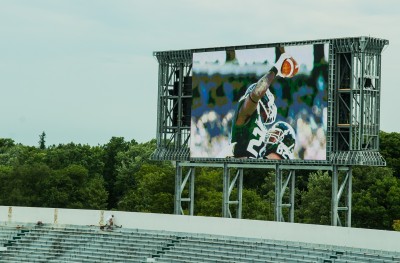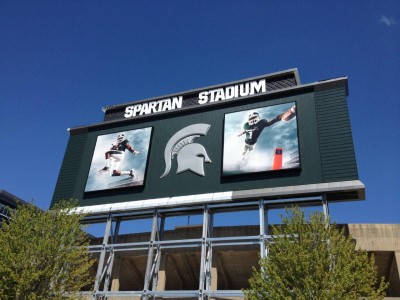
The Spartans won their home opener on August 31, 2012, giving fans their first opportunity so see a victory march on the giant HD LED screens.
Spartan Stadium
The love of football runs deep in East Lansing, Mich., where the MSU Spartans have called Spartan Stadium their home for more than 89 years. Once dubbed “the snake pit” by ESPN reporter Lee Corso, the stadium has a reputation as one of the most intimidating venues for opposing Big 10 Conference teams to visit. With a maximum capacity of 75,000, it is one of the largest stadiums in the National Collegiate Athletic Association (NCAA).
With an explosion in the popularity of college football across the U.S., there have been huge expansions of and improvements to many NCAA venues. At MSU, following two of the Spartans’ most successful seasons in 2010 and 2011, the board of directors approved a stadium renovation project with a budget topping $9 million. The scope of the project included removing and replacing the existing scoreboards with a pair of 202-m2 (2,170-sf) LED screens in the north end zone and one 483- m2 (5,200-sf) screen in the south end zone. In addition, a 3 x 137-m (10 x 450-ft) LED wall would span the entire north end zone.
With the addition of the new LED screens, much of the stadium’s advertising opportunities would move from static to dynamic signage, with a cleaner, updated look. This change left a massive canvas on the scoreboard structures for channel letters and logos.
So, the project also included an overhaul of the stadium’s permanent and corporate sponsorship signage. There were two sets of 2.1-m (7-ft) tall illuminated channel letters spelling out ‘Spartan Stadium,’ three illuminated Spartan head logos ranging from 4.9 to 8.5 m (16 to 28 ft) tall and two 9.8 x 9.8-m (32 x 32-ft) illuminated flexible-face sign boxes.

Large-format printing yielded two larger-than-life images of MSU players in action, which were installed on illuminated flexible-face sign boxes.
Working again alongside Icon HD, which designed the plans, Signs.ca was contracted to provide all of the signage to be incorporated in the new scoreboard structures. This was accomplished using aluminum and polycarbonates.
The large Spartan head logos were built as halo-illuminated sign faces with a dark brushed-aluminum finish, mounted on white background panels to increase contrast. The channel letters spelling out the venue name were built with brushed aluminum, 76-mm (3-in.) formed polycarbonate faces and 127-mm (5-in.) returns. The formed faces offered dimensionality to help set the letters apart from others. By not using trim around the edges of the faces, light was allowed to pass through the area between each face and joint to the sign can, resulting in a bolder style of illumination.
The flexible-face sign boxes were fabricated in four identical 2.4-m (8-ft) tall sections, then through-bolted to one another, for structural, shipping and installation purposes. The large-format faces were printed in high resolution in two 4.9-m (16-ft) sections, then seamed together, creating two larger-than-life images of MSU players in action.
All of the scoreboard construction and testing work was complete by August 10, 2012, well in advance of the Spartans’ home opener against the Boise State Broncos on August 31. The Spartans came from behind in the fourth quarter of that game to win 17-13, to the delight of a capacity crowd that got its first opportunity to see a victory march up close on 896 m2 (9,640 sf) of HD LED screens.
Anthony Kilgallen is a project manager for Signs.ca in Ottawa. For more information, visit www.signs.ca.





